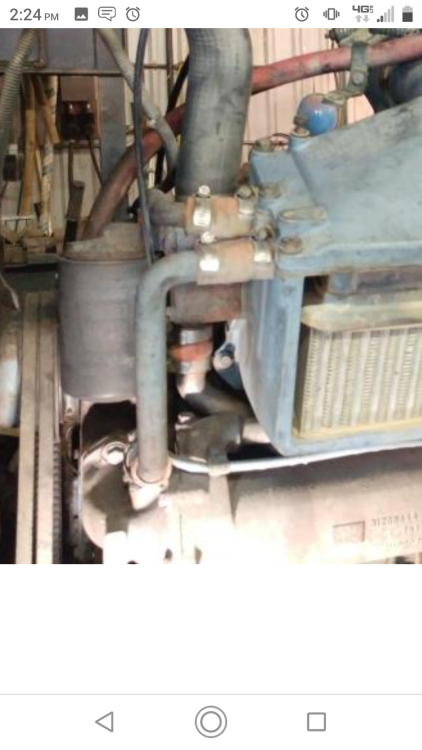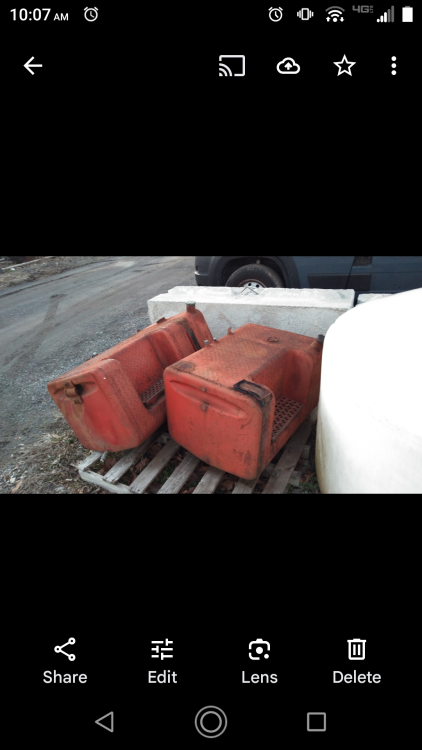
JoeH
Pedigreed Bulldog-
Posts
2,315 -
Joined
-
Last visited
-
Days Won
15
Content Type
Profiles
Forums
Gallery
Events
Blogs
BMT Wiki
Collections
Store
Everything posted by JoeH
-
Mack B Model Custom/Repower/Chassis Swap
JoeH replied to r8f1k's topic in Antique and Classic Mack Trucks General Discussion
Sign up for an Edison Motors diesel electric power swap! If you're training up the next gen of auto techs this is where the future is! -
@kscarbel2 were you the one a number of years ago looking to turn your Virginia property into a retired Veteran community? I thought that was a great idea, was annoyed to hear how much of a roadblock the local government was on it.
-
Tracked Down An Air Leak, Need Help ID'ing Part
JoeH replied to Grind's topic in Air Systems and Brakes
The type # indicates how many square inches of surface area pressure the brake chamber has. So a type 24 chamber has 24 square inches of surface area to compound the applied pressure. If you're doing a soft stop at 30 psi then 30 psi x 24 sq in is 720 lbs of force applied on the pushrod. If you're doing a hard panic stop and you're applying 100 psi then you're applying 2,400 lbs of force on the pushrod. If you're running type 30 chambers then those braking forces would be 900/3,000 lbs of force of the pushrod respectively. That rotochamber looks pretty big, it might be a type 36. You can measure the chamber diameter and run the math to figure out what size it is. 3.14 x radius squared should give you the size of the chamber so you know what size you'd need to replace it. -
Tracked Down An Air Leak, Need Help ID'ing Part
JoeH replied to Grind's topic in Air Systems and Brakes
Type 24's and Type 30's are far cheaper and more common. Rotochambers are basically just old style air chambers. -
Tracked Down An Air Leak, Need Help ID'ing Part
JoeH replied to Grind's topic in Air Systems and Brakes
I have 2 wheel loaders that use air over hydraulic brakes. The rotochamber applies the rod movement to operate the hydraulic master cylinder. If that one only operates the front brakes and the front brakes are already disconnected then you can unplug the air line from the rotochamber and cap it. Before doing this, verify that this rotochamber/master cylinder doesn't operate the rear brakes as well. If you plan on using this rig on the road then I'd say you need to fix the front brake system. If you're just using it on your own property then the safety of your own property is your call. You should be able to convert that rotochamber over to a Type 24 or Type 30 air chamber instead. -
Mack B Model Custom/Repower/Chassis Swap
JoeH replied to r8f1k's topic in Antique and Classic Mack Trucks General Discussion
Air ride cab no, don't think so. Air ride rear axle, yes. Air ride cabs, the front cab mounts would need to be hinge type pivots while the rear cab mount is air bags with a leveling valve. The issue will be on hood impingement. The cab will need to rotate on the front cab mounts, which will crush into the butterfly hood. -
Mack B Model Custom/Repower/Chassis Swap
JoeH replied to r8f1k's topic in Antique and Classic Mack Trucks General Discussion
Depends on suspension. Mack Camelback suspension, no, not without swapping entirely different suspension and axle in, which is entirely doable. -
Mack B Model Custom/Repower/Chassis Swap
JoeH replied to r8f1k's topic in Antique and Classic Mack Trucks General Discussion
Also not sure what your state's driver license laws are. In PA, a CDL is required for anything over a 26,000 lb weight rating. Also need an air brake endorsement to drive trucks with air operated brakes. And now if you take your CDL skills test in an automatic, you're restricted from driving manual transmission trucks. If you're looking to have a payload of 15,000-20,000 lbs on the truck then you're looking at needing a 33,000 lb GVWR, which in PA is max on a single axle truck. If you're trailering the load then that may buy you some wiggle room on the truck chassis you swap a cab onto. I believe you still need a CDL in PA if the gross combined (trailer and tow vehicle) weight rating exceeds 26,001 lbs, but I've always been fuzzy on the details on GCWR. -
Mack B Model Custom/Repower/Chassis Swap
JoeH replied to r8f1k's topic in Antique and Classic Mack Trucks General Discussion
As someone who owns one, I don't think you can beat a 5.9 12v Cummins, but I understand they may be pricey. They use a hydraulic brake booster off the power steering pump, so you remove the need for a vacuum pump. Personally I'd stick to a mechanical engine. Fuel and coolant and oil and you're running. Not sure what region of the US (I assume) you're in, but in PA there used to be a lot of Ford L8000 single axle oil delivery trucks. I have one I converted to a dump truck that has an 8.3L Cummins with a 6 speed transmission. Rear axle is geared for local driving, it'll do 55, barely. -
For easiest conversion I imagine you'd need the radiator/CAC from a later R model. E6, mid-late 1980's I would think could work. There will be some minor differences on hood hinge brackets, unsure if this would affect the radiator/hood alignment at all. These spring-type hood hinges combine with rollers on the cab/hood mating brackets to allow the cabs to have air ride rear cab mounts. The radiators then use a diagonal brace from mid radiator level back to the frame around the upper shock absorber bracket. The cab air ride wouldn't work with the old style rod braces that stabilize the radiator off the cab's firewall.
-
These coolant lines on your engine mounted CAC are weird. Looked at my 1979 the other day, it doesn't have those.
-
Around 10-15 psi is when the 283hp version kicks into the power band and really starts pulling. My gauge I added on my '79 endt676 only went to 25 psi and it pegs that pretty well. Not sure what the endt675 237hp motor does. Probably similar.
-
Dont know if these are what you're looking for. I was planning on cutting the fuel neck out of one to fabricate a filler neck for my flatbed pickup.
-
I've got a couple from a U model.
-
2000 & 2003 mr688 cab/chassis bulkhead wire connectors. Look like theres a big nut to unscrew before unplugging. Are there lock pins that need to be pressed in before undoing the nuts? There's 3 of these round plugs, one with probably 15 or so wires for the ABS on the pass side of radiator, and 2 with similar or more wire counts on the driver side if radiator. Doing a cab swap so I need to unplug these things.
-
You probably have all LED lights and the one incandescent bulb you have on the turn signals failed. Probably the dash indicator bulbs. There's a special turn signal flasher for LEDs that has a grounding wire coming out that you're supposed to attach to a good ground. LEDs don't draw enough power to trip the old style turn signal flashers, so they've made that special electronic one with the grounding wire to overcome this issue.
-
I think the best description of Biden is that he's a Post Turtle, which is a turtle sitting on top of a fence post! You know he didn't put himself up there, and he doesn't know what he's doing up there!
-
We had to add Prince pressure compensating valves to the auger and conveyor to balance the flow properly.
-
Volumetric concrete mixer. Has to run hydraulic water pump, conveyor, mixing auger all at certain speeds to maintain the right material ratios. We had a hydraulic company design the system for us, it's garbage. Section pumps are the way these trucks need to be set up.
-
We have a pump like that on one of our trucks, it's a piece of sh*t in our application, but the swash plate adjusts very fast on ours. Our system requires multiple hydraulic valves to need to be synchronized, and the type of control valves don't allow for it well.
-
Getting ready to do a cab swap myself. Dealer says they gut the donor cab, and transfer all harnesses over from old cab into donor cab. Too many truck specific options to just plug and play.
-
Sounds like the o-ring in the shifter tower was missing. Our Eaton 8LL would do that. Bought it used, and after the second time fixing it on the road we drove it back to the yard, pulled the tower out, disassembled, and found bits of what was left of an o-ring on the top side of the shifter ball/socket. New o-ring, hasn't happened in the past 10 years now.
BigMackTrucks.com
BigMackTrucks.com is a support forum for antique, classic and modern Mack Trucks! The forum is owned and maintained by Watt's Truck Center, Inc. an independent, full service Mack dealer. The forums are not affiliated with Mack Trucks, Inc.
Our Vendors and Advertisers
Thank you for your support!







